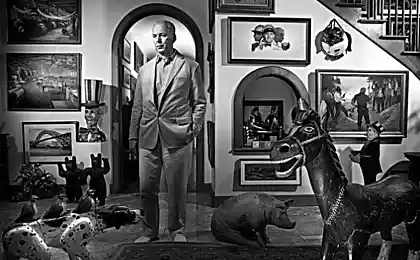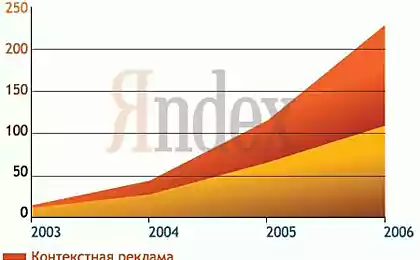723
Features of the art market in the twenty-first century
Bookseller: Not for sale inspiration, but you can sell a manuscript.
Poet: You are absolutely right. Here's my manuscript. Agree.
A. S. Pushkin
In a conversation about contemporary art, it is impossible to shy away from the topic of market relations. The famous formula of Pushkin, which is like a prayer repeated by all the artists trying to sell their work, according to many theorists of art, remain forever in the XIX century.
The market is tough and cynical not only asserting their rights to participate in the formation of supply and demand for works of art (in varying degrees always), but began to dictate the actual strategy of the development of art, investing is most effective from a commercial point of view, projects. And Commerce in this context involves both direct and indirect sale of art.
In the first case as two hundred years ago sold "manuscripts", that is, the finished works of art. But the feature of today was the fact that gallerista not only to take away the finished work, but also to steer the activities of the most promising from a commercial point of view of artists and curators. Analyzing the activities of the oldest art Biennale in Venice, art historian Gareth Harris writes in the Art newspaper that an independent review of the achievements of modern art today has become a commonplace showroom to familiarize yourself with the trends before you buy works of art at the fair Frieze New York. Harris in his article proves that today the Biennale is directly dependent on commercial interests and tastes dealers and collectors. Responsive to market demand gallerist not only promote their protégés on the major art forums and festivals, but also lit many new bright stars on the firmament of contemporary art. A typical example of this kind can serve as the initial promotion and assignment vector "creativity" Damian Hernst done by Saatchi. The artist in the chain becomes the Central figure of the brand and must "do" in an extensive advertising campaign, which gallerista carried out with the help of biased critics, curators and journalists.
Sometimes the artist even creates the work of art as such, but sells the kind of action that fit into the honeycomb modern art. "I would compare a contemporary artist with a circus artist who travels and shows the room — said in an interview, Boris Groys.
And if he jumps through a burning Hoop, or riding on Panther, this circumstance is not linked in any meaningful, either thematically or ideologically with the city in which he rides, with the event about which he rides. The event can be anything — from the Dormition to the Day of children. It will be the same wrap and the same Panther. It is unclear what is the reason for that, and there is no unity of meaning". And here we come to the commercial art of the second kind in which the goods were the ideas, ideas and creative suggestions. Universal development grant system, which originated as a support and sustain non-profit art quickly led to a whole new, unimaginable in the XIX century paradoxical kind of trade. Artists and curators began to sell not just inspiration, but the FUTURE is the inspiration that must inevitably attend them after certain financial investments.
The grant market is very quickly formed around the extensive infrastructure. Of course, here (especially in the field of state subsidies) has blossomed corrupt system of "supporting the arts" (particularly in Russia according to different sources of kickbacks for the grants reach 70%). But, even excluding from the grant of trade shadow Commerce, we are confronted with an amazing development experience of selling art the future of art! How to write a grant proposal creates all sorts of instructions, written books, developed separate sites; conducts seminars and webinars. The same Boris Groys in one of the articles says something like: "If early to my lecture went enthusiastic girls who were interested in modern art, now they were replaced by purposeful young people who ask for someone better to refer the application for a particular grant on Derrida or Bataille" (quoting from memory). In our eyes the art of receiving and reporting on grants transformed, into a kind of profession.
Many artists and curators apply for various grants, scholarships and grants to almost daily! In fact the art of writing applications has become much more important than the art that calls the aesthetic experience. However, this does not mean that among grant art is interesting and worthy projects. Among them there is a non-profit project! Just in this case to replace the classic formula of the circulation of capital is money-commodity-money, came to a fundamentally new working scheme idea-money-effect. And any artist that are applying for subsidies for your project, inevitably falls into this new commercial chain. It should be noted that grantees have a vested interest in creating a spectacular project, because the effectiveness of implemented projects, is the key to obtaining grants for the following projects. Of course, selling the future of ingenious projects, is not an invention of modern times.
And, for example, Leonardo da Vinci was not only a great painter but also a brilliant schemer, who managed to sell a lot and unrealized engineering projects. But today the trade "brilliant" ideas put on a stream, which, of course, a new and progressive step in the development of the market of art. However, under the new scheme trade all the disadvantages of commercial art is not going away. In this scheme, art is still forced to rely on market conditions. Which different sectors can sometimes wear the opposite character. Experienced grantee will study the policies of the Fund, ask about interests and priorities of the members of the Advisory Board and will never apply contrary to the General line held by the Fund or by the state, if the application is submitted to the state structure. And therefore, if he wants to continue to live on subsidies, they must meet the expectations of their benefactors.
Here it should be noted that patronage of the arts, descended almost from the arena of contemporary art and sponsorship are two fundamentally different support lines of the artistic process. If patronage was unselfish and carried out solely for the love of the art, the sponsorship is always this or that interest, some of whom are innocent of the tax evasion, and advertising of the company, and there are money-laundering and political propaganda.
Patron almost always decides — who and what it should support. (In the modern world I know of one major patron Antonio Presti, who carried out a number of ambitious projects in his native Sicily and always personally took part in them.) Sponsor, always establishes a Council, a Fund, a particular institution that will work, Holy respecting the interests of its founder. Patronage does not require from the artist an immediate effect (Yes, by and large nothing requires, for example, Tchaikovsky lived and worked on the money Nadezhda von Meck, which was important only that he writes the music). The sponsor always expects impact and dramatic effect, attracting attention.

Consider the relationship of modern "free" artist and commercial art. The classical way of trading the artist (if he wants to sell their work) is a hard addiction to galleries and auction houses that shape consumer demand. If these or other artistic solutions has found commercial success, the artist will push to work is in line with these successful solutions. And if he suddenly wants to make statements in an entirely different manner unlike gallerista strongly advise you to abandon such experiments, or at least to take such work a pseudonym to experiment and have fun outside of the art business.
"Working with creative people is hard in one case, if you have not written a contract that clearly defines all the effects for a change in the creative impulse, of inspiration." says art Manager Denis Belkevich. The market like planning and certainty. And if your radical gestures was a success, and continue to do them, but under written contract. In the words of Henry Ford "the Car can be any color, but always black!" So the artist is free in his work, but must do what he says gallerist, if you do not want to become poor. "It is widely believed that the market moves art, helps bring out the best work. writes Maxim Kantor. — The reality is just the opposite — the market has always contributed to the oblivion of the major artists, focusing on the cabin. Salon (that is, an average idea of fashion and the needs of society) has always won. Piece goods market is not interested: Botticelli, El Greco, Rembrandt was forgotten and died in poverty".
In the second method of trading, when the artist sells their future creativity, he escapes from the clutches of the salon in order to become dependent on stock strategy. In this case, the "free Creator" all crook must demonstrate relevance, relevance, "usefulness" of his art. That is the artistic Creator of free need to retrain skilled in the art of the strategist.
In one of his posts on Face book by Gelman writes that if youth were carried out 1 out of 10 proposed projects, now shoots almost every. That is an experienced curator or the artist is keenly aware of the full range of opportunities and is always working in the most promising direction. And if before many of the great artists try to do the impossible and to go beyond the narrow confines of the contemporary reality, today grant support system dictates the choice of possible strategies. Oddly enough, but the greatest freedom an artist has when the shadow of Commerce, since in this case the official, providing money, are only interested in the percentage of rollback, and the content of the project may fit in the policy of allocation of funds on purely formal grounds. Of course, as the first and the second type of art-Commerce for many artists happen "happy" coincidences, when their own interest collinear strategic course of galleries or foundations. While the rate of the latter is, ultimately, mass demand, or the proverbial "useful" for the development of society. That is, roughly speaking, if the society is more interested in the beauty and flights of the spirit, and the disgrace and fall, the winners will be mental perverts and moral since the update (which is actually what we observe in numerous examples).
A mentally normal person for any price not to have sex with dogs or nail your scrotum nailed to the pavement. And not coincidentally, many modern artists have become favorite characters of psychoanalysts, drawing in their "creativity" numerous examples for study. (This trend has the opposite effect, when a "healthy" artists study psychoanalysis, in order to forcibly cram his ideas into his art.)
Of course, we cannot claim that today the art business has completely taken away from the artist creative freedom. Differentiation as an extensive gallery of trade and distribution of grants, allows the artist to find commercial niches coincide with his personal interests. However, the structure changed the status of the artist. From "ruler of doom" he was turned into a "spokesman" of the pioneer and rebel in the actor, put on a show for the sake of the idle public.
Of course, among artists today, as at all times, is disinterested, who sees in art the meaning of life, and standing aloof from any manifestation of the art market. But apart from them, still have some niches in which free creativity and the commercial market exist in a certain harmony and the Pushkin formula remains in them is still relevant. It is such a niche artist's Book. Starting from his birth, the artist's Book developed in two absolutely opposite and conflicting commercial trends. The first trend took shape within the framework of the Livre d'artiste. Under this trend was created, the de Luxe as publishing project initially produced for commercial sale.
However, the publisher, in this case, bought as poets and artists, manuscripts and drawings in no way encroaching on their inspiration. The famous Ambroise Vollard for his editions could take away illustration of the working artist, but if made an order for clearance of certain texts almost never interfered in the creative search of the artist. That is, in this case, we can observe a completely harmonious symbiosis, when the artist studied art, and publisher engaged in Commerce.
Another trend that began with the revolt of Russian futurists, were developed in the conceptual works of the artist's book in the 1960s. Here, artists are seen in the book in the first place a tool for carrying out their ideas to life. And, of course, they sought to make their work accessible to the wider layers of spectators. Selling books, in this case almost did not pursue the purposes of profit, and if the trade pays for the production costs, the project was considered commercially successful. That is, in this case, rather than the art work on the market, and the market for art, because the money from sale of old projects immediately spent on new ideas. Futurists and the trade turned into art. "Again today I will go / Back to life, bargaining, market And army songs lead / surf market into the match," he Velemir Khlebnikov.
Both of these trends have survived to this day. Publishers Livre d'artiste continue to buy from the artists illustrations for their projects and to publish a luxurious book. The second trend that emerged on the wave of protest movements (the revolt of the futurists against the old art, the protest of the sixties against the dominance of the dictates of galleries and museums) today, of course, has undergone some changes. However, the basic principle is rather strange from the point of view of any business trade, putting at the forefront the bait, and in many cases preserved. An important feature of the artist's Book in contrast to other art forms is the presence of circulation. And in this case, each copy of the book is original, not a copy. The presence of copies allows the artist much more freedom to treat the sale, donation, exchange — any parting with their child.
Most I know of beech-actors aimed at the creation of books and almost always, the proceeds from the sale of their work allowed for the implementation of new projects. The book is for the artist becomes the meaning of work, an invaluable tool, allowing for complex fulfillment, a kind of method of understanding the world, and if part of the circulation is sold, this is treated as an added bonus! Very often I personally and many of my colleagues faced with a proposal to repeat the circulation, the most successful from a commercial point of view books, and it does not seem strange to any businessman, but almost nobody ever repeats (at least not that I know of). And it is irrefutable evidence that beech-artist is much more important to make a new book than to repeat the old for the sole purpose of profit.
Another important feature of the market of the artist's Book is that all the fairs, the artists themselves sell their own books on the rented stands. Of course, there are fairs and galleries, but their share is insignificant. Direct contact with customers is really important for the artist. In the main body of the art market, the artist, as a rule, such contact is absent. As I wrote above, he becomes a hostage to the tastes of galleries and salons, but no less important hostage to this taste becomes and the buyer! At the fairs of artist Book buyers and artists have a great opportunity to communicate with each other directly. In my own experience I can confidently say that the direct response of buyers and connoisseurs of the creativity gives the artist an invaluable experience. It is important not only what is the most popular, but one. Quite often, regular customers become friends of the artist. And this is not entirely surprising, since in this case they just can not be General spiritual interests.
Far be it from me to idealize all Buk-artists and make them last knights free art. Of course, among them there are those who keenly keeps his nose to the wind market demand, and for whom selling books is the main purpose of the work. However, it seems to me that the situation on the market of artist's Books, suggests the possibility of fruitful interaction and exchange between Commerce and free artistic creativity.published
Author: Mikhail Pogarsky
P. S. And remember, only by changing their consumption — together we change the world! ©
Source: syg.ma/@mikhail-pogharskii/mikhail-pogharskii-osobiennosti-art-rynka-v-xxi-viekie
13 wonderful women over 60, who seem to with age become more beautiful
Social networks as a tool for studying the psychological portrait of the consumer























